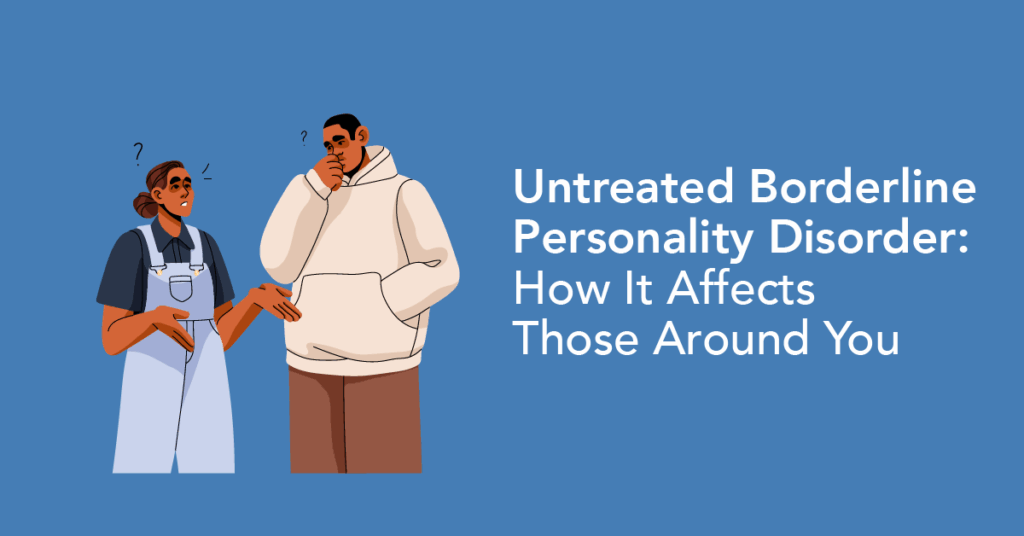Borderline personality disorder is a serious mental health condition that can deeply affect the individual and their closest relationships. Living with BPD can feel like being on an emotional roller coaster, marked by intense mood swings, fear of abandonment and unstable self-image. But when BPD goes unrecognized or untreated, the emotional fallout doesn’t stop with the person experiencing it. It often spills over into relationships with partners, friends, coworkers and family members.
Understanding the signs of untreated BPD and how it impacts others is the first step toward compassion, boundaries and healing for everyone involved.
What Is Borderline Personality Disorder?
BPD is a complex mental health condition characterized by:
- Intense and unstable emotions
- Difficulty with self-identity
- Fear of abandonment
- Impulsive or self-destructive behavior
- Rapidly shifting relationships
An estimated 1.4% of adults in the United States live with BPD, and nearly 75% of diagnosed cases are women, although it’s believed that many men go undiagnosed or misdiagnosed.
The exact cause of BPD is unknown, but research points to a combination of genetic, environmental, cultural, social and neurological factors — including childhood trauma and invalidating environments.
Can BPD Be Treated?
BPD can absolutely be treated. While it was once thought to be untreatable, we now know that, with the right therapy and support, many people with BPD experience dramatic improvement over time. Evidence-based treatments include:
- Dialectical behavior therapy. DBT is the gold standard for BPD, focused on emotional regulation and distress tolerance.
- Mentalization-based therapy. MBT helps individuals understand their own and others’ mental states.
- Schema therapy. This targets core patterns and beliefs formed in early life.
- Medications. These manage co-occurring symptoms, such as depression or anxiety.
With commitment and care, many people with BPD go on to build stable relationships, careers and a strong sense of self.
What Happens If BPD Goes Untreated?
Untreated BPD often leads to chronic emotional pain for the person struggling and the people around them. Without treatment, symptoms can intensify and lead to:
- Frequent emotional outbursts or breakdowns
- Instability in jobs, housing or relationships
- Self-harm or suicidal thoughts
- Substance use or risky behaviors
- Isolation or abandonment by loved ones
While not everyone with BPD experiences all these outcomes, untreated symptoms can create a cycle of crisis that’s exhausting for everyone involved.
BPD in Relationships: How It Affects Others
Relationships are where BPD often shows up most intensely. The fear of abandonment, difficulty trusting and black-and-white thinking can create a push-pull dynamic that’s painful for both parties.
Here’s how BPD in relationships can affect loved ones:
- Emotional Whiplash
BPD can cause someone to view others as either “all good” or “all bad” — sometimes within the same day. This idealization-devaluation cycle can leave partners, friends and family confused, hurt or walking on eggshells. - Fear of Abandonment
A person with BPD may perceive even minor actions (such as a delayed text) as signs of rejection, triggering panic or rage. In response, they may lash out, beg for reassurance or withdraw suddenly. - Manipulation or Control
While rarely intentional, untreated BPD can involve emotional manipulation, such as guilt-tripping, ultimatums or threats of self-harm, as a way to avoid abandonment or manage overwhelming feelings. - Chronic Conflict
Mood swings and emotional sensitivity can lead to frequent arguments or misinterpretations. Loved ones may feel constantly “on alert” or unsure of how to respond. - Caretaker Burnout
Friends or partners may feel responsible for the emotional well-being of their loved one with BPD, leading to exhaustion, resentment or burnout, especially if boundaries are lacking.
The Impact on Families and Children
When BPD goes untreated within a family, especially when a parent has the disorder, it can create an unpredictable emotional environment for children. Kids may experience:
- Confusion about emotional cues
- Fear of setting boundaries
- Parentification (taking on adult roles early)
- Anxiety or attachment issues later in life
Parents with BPD can be loving and supportive, but without treatment, emotional dysregulation can unintentionally create instability in the home.
How Loved Ones Can Cope
If someone close to you has BPD, here are some ways to care for yourself while maintaining the relationship:
- Learn about BPD. Understanding the disorder helps reduce personalizing the behavior.
- Set boundaries. Clear, respectful limits protect both parties from resentment and enmeshment.
- Don’t try to be their therapist. Support is helpful, but treatment needs to come from professionals.
- Practice self-care. Caregiver fatigue is real. Therapy, support groups or time away can help.
- Encourage treatment. Gently guide your loved one toward professional help while accepting that you can’t force it.
The most powerful tool is empathy — recognizing that BPD isn’t a choice but a condition shaped by pain.
When to Seek Professional Help
If you or someone close to you is showing signs of BPD, or if your relationship is suffering due to emotional instability, seeking help is a vital first step. Signs it’s time to reach out include:
- Escalating conflict in the relationship
- Frequent threats of self-harm or suicide
- Inability to maintain trust or safety in communication
- Feeling emotionally drained, confused or fearful
- A desire to heal but not knowing how
The Mental Health Hotline is a free, confidential resource where you can talk to someone about what you’re experiencing and get connected to providers who specialize in personality disorders and relationship dynamics.
Frequently Asked Questions
Yes. BPD is highly treatable, especially with therapies such as DBT. Many people experience substantial symptom reduction over time.
Untreated BPD can lead to chronic emotional distress, self-destructive behaviors and relational instability. It can also contribute to depression, substance use or suicidal thoughts.
BPD can cause intense mood swings, fear of abandonment and difficulty trusting others, all of which may lead to conflict, miscommunication or push-pull dynamics in relationships.
DBT is the most well-established treatment, but other approaches, such as MBT, schema therapy and trauma-informed care, are also effective. Medications may help with co-occurring symptoms.
Yes, especially when they’re in treatment. With communication, boundaries and support, many people with BPD build deep, fulfilling relationships.
Healing Is a Team Effort
Loving someone with BPD or living with it yourself can feel overwhelming. But healing is possible, and no one has to go through it alone. If you’re navigating the impact of untreated BPD or you’re unsure where to start, the Mental Health Hotline is here to help, confidentially, compassionately and for free. Contact us today.
Editorial Team
-
 Written By: Mental Health Hotline
Written By: Mental Health HotlineMental Health Hotline provides free, confidential support for individuals navigating mental health challenges and treatment options. Our content is created by a team of advocates and writers dedicated to offering clear, compassionate, and stigma-free information to help you take the next step toward healing.
-
 Reviewed By: Raymond Castilleja Jr., LCSW-S
Reviewed By: Raymond Castilleja Jr., LCSW-SRaymond Castilleja Jr., LCSW-S, MBA, MHSM is a behavioral health executive with over a decade of leadership experience in integrated care and nonprofit health systems. As Director of Behavioral Health at Prism Health North Texas, he oversees strategic planning, clinical operations, and service delivery for a program serving the LGBTQ+ community. He has led the successful integration of behavioral health into primary care and played a pivotal role in securing $5 million in SAMHSA...


